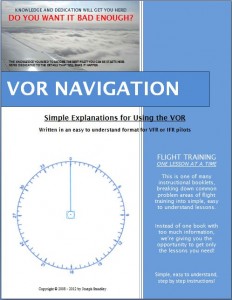How well do you know VOR’s? Do you know to intercept and track a VOR radial or use it for navigation. Can you tell by looking at your chart, which ones have DME and which don’t? Can you identify the morse code on it? If you ever get lost or disoriented they are perfect for finding your position, but would you know how to use them to figure it out? There are many student pilots that struggle with VOR’s. They can explain them perfectly on the ground but when they get in the air and start to use them, the confusion sets in. Don’t worry because private pilots have a hard time too.
Assuming that you know the basics of a VOR, let me give you a couple of tips that can make things a little easier for you when using them. Many people get the TO or FROM indicator confused and they are not sure which one they should be using. The needle will always center with a TO setting and a FROM setting, so which do you use? Tip number one: if you are going TO a VOR, then use a TO setting. To make it even easier, the ONLY time you should use a TO indication is if you are heading directly TO the VOR you are using to navigate. All the rest of the time, you will use a FROM setting.
If you want to go directly to a VOR, just center the needle with a TO setting and fly the direction indicated at the top of the VOR (plus or minus wind correction as needed to stay on course). If the course shows that you have to fly 273° to get there, then you should be heading the same general direction toward the west.
Tip number two: if you want to fly to a VOR and you KNOW the VOR is somewhere Southwest of you, then you also know to fly to it you will be flying Southwest. If you know you will be flying Southwest and that the general direction of the course indicated above the VOR should be the same, then you can expect the needle to center somewhere between South and West. If you know it will center between South and West, then spin the dial quickly to get it to South or West and then turn it slowly from there to center it. The TO indication will be automatic.
What about for those of you that don’t have a clue how to use a VOR? You’ve read books, received instruction with the same explanations as the books leaving you just as confused. You’ve heard the terms TO and FROM, Reverse Sensing, Intercepting and Tracking, etc. and you just don’t get it.
We have the perfect thing for you; an e-lesson in pdf format with detailed, plain english explanations, written in an easy to understand format, eliminating all the confusing terms to help you understand once and for all. It includes diagrams and simple explanations for better visualization. Knowing how to use VOR’s will make things easy for you and will be required if you ever want to get an instrument rating. For the price of about 10 minutes with an instructor, it’s well worth it!
VOR NAVIGATION – Detailed, easy to visualize explanations and diagrams to eliminate confusion. Intercepting and tracking and more. Just a couple of simple things to remember to avoid confusion.
$9.95
Testimonial
Hi Joe,
I read through the VOR lesson today from your website. THANK YOU!
Before getting your VOR lesson, I read both the test prep and handbook sections on VOR’s from other books and could follow what they were saying but not apply it. I would take practice tests and get several of the questions wrong.
After I read your booklet, I went straight to the Gleim and ASA test prep questions. The only one I missed was because I estimated a length (NM on a chart) incorrectly. So it works! I had to go back and reread my textbook to see why I was so confused in the first place because it seemed straight forward after your description.
I think the reason I understood your method better was you described and then applied each portion of a difficult topic individually. The difference seemed to be you took each part; Radial, CDI and to/from, explained it and then immediately demonstrated how to apply it. Like–you’ve got to learn to hold altitude in level flight before you start practicing stalls with minimum altitude loss. I’m still working on that one.
Have a good week.
Lindy


